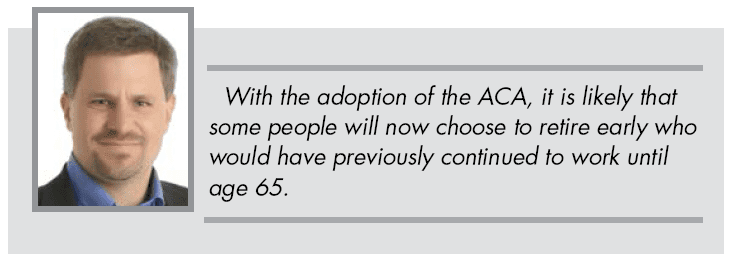Covering the Basics – Understanding the Potential Benefits of Obamacare for Early Retirees
The cost and availability of healthcare has been one of the drivers keeping people working until they qualify for Medicare at age 65. With the implementation of the Affordable Care Act (ACA), better known as Obamacare, some of the uncertainty of medical coverage for individuals will disappear.
Early retirees will be able to get healthcare coverage, and for people with modest incomes, they will get a subsidy to help with the cost. With the adoption of the ACA, it is likely that some people will now choose to retire early who would have previously continued to work until age 65. Physician practices may want to consider the possibility that some of their employees will decide to stop working earlier than they anticipated.
Under the ACA, insurance companies can only set health insurance premiums based on age, geography, family size, or whether the person is a smoker. All plans must cover “essential health benefits,” including preventive care, prescription drugs, lab services, mental-health treatment, maternity care, hospitalization, and emergency services. There can no longer be a limit on the lifetime benefits you can receive. For people with chronic health conditions or other pre-existing conditions, they no longer need to fear being rejected from coverage or having sky-high insurance premiums.
The ACA also helps with the cost of health insurance for early retirees if they make between 100{06cf2b9696b159f874511d23dbc893eb1ac83014175ed30550cfff22781411e5} and 400{06cf2b9696b159f874511d23dbc893eb1ac83014175ed30550cfff22781411e5} of the federal poverty level. In 2014, an individual with an income between $11,670 and $46,680 will be eligible for a subsidy to offset the cost of health insurance. For a couple, the income range to receive assistance is $15,730 to $62,920.

How Much is the Health-insurance Subsidy?
Insurance on government-run health exchanges comes in four levels of service: bronze, silver, gold, or platinum. Bronze plans have the lowest premiums and the highest out-of-pocket costs. Platinum plans have the highest premiums and the lowest out-of-pocket costs. Subsidies are based on limiting the percentage of annual income that must be utilized to pay for a silver-level health plan. A silver plan in Massachusetts may range in cost from approximately $10,800 per year to $14,400 per year.
For example, according to the Henry J. Kaiser Family Foundation, a couple with an income of $50,000 per year would be expected to utilize 9.5{06cf2b9696b159f874511d23dbc893eb1ac83014175ed30550cfff22781411e5} ($4,750) of their income to pay for health insurance. The couple would be eligible for a subsidy in the form of a government tax credit to cover the remainder of the premium cost (but not the other out-of-pocket costs). A couple with an income of $30,000 per year would be expected to contribute 6{06cf2b9696b159f874511d23dbc893eb1ac83014175ed30550cfff22781411e5} of their income to health-insurance premiums ($1,800). The remainder of the cost would be covered by a subsidy.
Determining Income
The applicant’s family income for the ACA is considered to be the modified adjusted gross income (MAGI) for the current year. MAGI includes most forms of income, including wages, interest, dividends, capital gains, distributions from IRAs, non-taxable interest income (ie, from municipal bonds), and non-taxable Social Security income. The MAGI number must be calculated; it is not on your tax return.
For early retirees without healthcare coverage from an employer, managing MAGI will be an important element in their income and cash-flow planning. Many early-retiree couples will have an income less than $62,920 and therefore be eligible for a subsidy (in the form of a health-insurance tax credit) worth thousands of dollars. But if they exceed the limit by even $1, they will get no subsidy. And the lower your MAGI, the greater your subsidy will be. If you take a distribution from your IRA to pay for repairs to your house, your MAGI will go up, and you might receive a smaller subsidy or possibly no subsidy at all.
For better or worse, the ACA does not take into account assets in determining eligibility for subsidies. Many retirees with substantial wealth may actually have very low incomes before they start collecting Social Security benefits or being required to take distributions from their IRAs at age 70 1/2. It is entirely possible that an early retiree with $1 million or more in investments could qualify for a health-insurance subsidy.
Early retirees can limit MAGI by not withdrawing money from IRA or 401(k) accounts, not collecting Social Security benefits, and placing income-generating assets (such as bonds and real estate) into retirement accounts. They will also want to limit the sale of investments that might trigger large capital gains. Money to cover expenses can come from savings accounts, investment accounts, or Roth IRA accounts. Generally, you need to be over age 59 1/2 to take distributions from your Roth IRA without incurring an early withdrawal penalty.
Looking at the Big Picture
Each person considering retirement needs to consider the entire length of their retirement years before deciding to stop working. Health are coverage is only one of those factors. Figuring out what you will do with your time, determining your expenses, calculating a strategy to maximize your Social Security benefits, and determining how to generate a sustainable income stream from your investments are a few of the other things to consider.
Potential early retirees need to be careful not to stop working too early just because they can now get affordable healthcare coverage. Continuing to work has many financial benefits, including increasing your Social Security benefit and building up your financial nest egg.
Physician practices and other healthcare employers may want to ensure that their employees are well-versed in all of the things they need to consider in retirement to help prevent employees retiring before they are truly prepared. You may want to consider inviting your financial advisor or 401(k) representative to speak with your employees on retirement planning.
Doug Wheat is a financial planner with Family Wealth Management Inc.; www.fwmgt.com



Comments are closed.